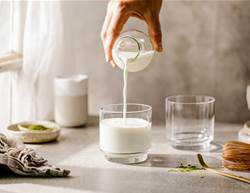Starting a new healthy journey is exciting, but it can also be a bit daunting. It’s not easy to stop filling your body with lashings of sugar, fat and salt, especially if you’ve enjoyed it your whole life. But just think of all that tasty, colourful, nutritious food that awaits! Keep reading and we’ll show you how to get started, keep going and not be tempted to look back.
1. Prioritise plants
Vegetables are rich in vitamins, minerals, antioxidants and fibre – and nearly devoid of the kilojoules, sugar and preservatives known to cause health issues. Only problem? Most people don’t eat enough of them. So dig in today!
2. Get real
If you can imagine it growing out of the ground or being raised on a farm, it’s real – and really good.
3. Choose just one
Foods with only one ingredient – think milk, raw nuts, raw chicken, broccoli or beans – haven’t been processed and are therefore better for your health.
4. Ditch the packaging
Choose foods that don’t come in packages, such as fresh fruit and vegetables, meat, fish and nuts.
5. Eat what you can pronounce
If you can read the ingredients out loud without looking at a long chemical name and thinking, “huh?”, then it’s probably good for you.
6. Give up the sweet stuff
To really improve your diet, avoiding sugar in its various forms and disguises is important. Steering clear of added sugar will let your taste buds adjust to noticing the natural sweetness in many fresh foods, so you’ll enjoy them much more.
7. Deconstruct a single day of eating
The first step to tweaking your diet is to take stock of everything you’re currently eating. Write it all down: Tally up the number of packaged or processed foods on the list, note what time of the day you’re consuming the least nutritious foods, and then pick a specific point where you’ll dive in and start making gradual changes. “Breakfast is a great way to transition to healthier eating,” says nutritionist Nicole Silber. Try swapping sweetened cereals with untoasted muesli topped with chopped fresh fruit, or wholegrain toast with peanut butter, instead.
8. Skip the diet labels
Paleo, raw, vegan, vegetarian, gluten free, dairy free? As long as you’re eating whole foods, choose whichever meal plan works best for your lifestyle.
9. Get familiar with ingredients
While you may already scan nutrition panels for kilojoules, chances are you don’t take a hard look at the ingredient list. Nutritionist Nicole Silber recommends sticking to foods with no more than five ingredients. And be alert to sweeteners, including ‘natural’ ones like stevia, rice malt syrup or concentrated fruit juice or extract. Ingredients are listed from the highest to lowest amounts, so if some form of sugar is the first ingredient, then put it back on the shelf. And if an ingredient is listed last, it doesn’t mean you’re consuming a small amount of it either – it’s all about how it stacks up against the other ingredients.
10. Clean out your pantry
Once you’re comfortable with analysing label ingredients, open up your kitchen cupboards and pantry and start to rid them of the foods that aren’t what you ought to be eating. As much as it hurts to throw away things you’ve already paid for, it’ll help you out in the long run. Also go through your fridge with the same eye you’ll use at the supermarket. Anything you would’ve put back on the store shelf goes straight in the bin.
11. Work (or walk) through your cravings
As anyone who’s ever eaten an entire packet of biscuits while hunched over a work project knows, cravings are often a result of stress. So instead of giving in, take that walk. “One of the easiest things to do when you have a craving is to go outside,” says nutritionist Joshua Nachman. If that strategy doesn’t work, reach for a filling, nutritious snack, such as plain Greek yoghurt topped with some fruit. Eventually, you’ll find yourself having fewer cravings, and when you do give in, you might not even enjoy the junk foods you once loved. Nicole, who gave up sugar in her coffee and tea in her own switch to a healthier lifestyle many years ago, says she can’t even tolerate sweetened drinks anymore. “When I did try a while after I stopped drinking it, it was too sweet for me,” she recalls.
12. Focus on what you’re adding, not what you’re cutting out
Okay, so you’ve done some purging in your pantry, fridge and freezer – a task you’ll only have to do once. Now comes the fun part: filling your kitchen back up with satisfying, delicious and health-boosting foods. As you begin your journey to eat well, you’ll want to stock up on a variety of fruits and vegetables, wholegrains, nuts and seeds, lean proteins and healthy fats. These will be the pillars of your new eating plan.
13. Build a healthy freezer
Being time poor can lead you to make quick and unhealthy food choices. But what if it’s just as easy to make good choices? Stock your freezer with frozen vegies (it’s just as beneficial as fresh and comes in a variety of mixes) and frozen plain chicken and fish fillets. Tossing together a simple stir-fry is then a speedy mid-week no-brainer. Frozen fruit, whatever your favourite, is a simple way to add a touch of nutritional sweetness to plain Greek yoghurt or muesli.
14. Make smarter menu choices
The bane of any newly adjusting healthy eater’s existence is a night out with friends who order every fried thing on the menu. But dining out doesn’t have to mean giving in, since many menus have healthier options. (We didn’t say 100 per cent healthy, because sometimes eating well means picking the better-for-you option.) To make a healthy choice, Joshua suggests easing yourself into a decision. “Rather than picking up the menu immediately, settle in for a bit, talk to your friends and relax,” he says. “When you’re in a more relaxed state and checking in with your body, then you can figure out what you’re actually craving.”
15. Don't deprive yourself
Most experts agree that the only way you’ll be successful is if you’re happy with what you’re eating. So if there’s one junky food that brings you such immense joy that you can’t picture life without it, keep eating it. A little treat here and there isn’t going to kill you and isn’t going to derail an otherwise healthy lifestyle, so rein in your guilt. “If you feel guilty, you’re going to inhale it before you taste it and then you’re going to reach for more,” says Joshua. To avoid this scenario, take a small portion, put the rest away and then savour it.
16. Eat dinner for lunch
Eating healthier typically means making the majority of your own meals. (No more hitting up the takeaway every lunchtime.) But cooking dinner and packing lunch every day can feel daunting. Joshua’s solution: just make more dinner. “Eating leftovers is a simple way to upgrade your lunch,” he says. “Soups and stews are especially easy to make in large batches.” Or fill a lunchbox with salad vegies and chicken, fish or another lean protein.
17. Stop counting kilojoules
The reason? It’s unnecessary and even counterproductive. Healthy eating isn’t a diet. As you start to cut out the junk and embrace truly nourishing foods, you’ll get better in tune with your body and understand how much you need of certain foods to feel satisfied, energised and healthy – that is, you’ll naturally self-regulate. Counting kJs, on the other hand, has you focusing on a number and often results in you feeling guilty when you don’t wind up with the numbers you think you should have at the end of the day.


.jpg&h=90&w=90&c=1&s=1)




.jpg&h=193&w=250&c=1&s=1)


